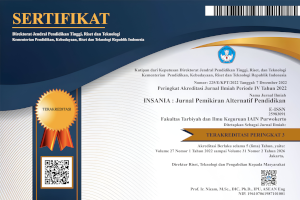Studi Analisis Penilaian Kemampuan Berpikir Tingkat Tinggi Level I Tahap Decision Making Menggunakan Model Poe Berbasis Inkuiri-Humanistik pada Praktikum Fisika Dasar
Studi Analisis Penilaian Kemampuan Berpikir Tingkat Tinggi Level I Tahap Decision Making Menggunakan Model Poe Berbasis Inkuiri-Humanistik pada Praktikum Fisika Dasar
DOI:
https://doi.org/10.24090/insania.v22i2.1209Keywords:
POE Model, Inquiri-Humanistic, HOT level IAbstract
High-level thinking skills are an important capability as part of the problem-solving process. This study aims to determine the ability of high-level thinking at the level I decision-making phase before the initial problem-solving stage, namely the large size of the influence of the application of the model POE Inquiri-Humanstic (variable x) to the ability of thinking high level level I at the decision-making stage (variable II) . This study uses the application of inquiry-humanistic POE model as a solution in solving the problems that are being developed by physics education students. The subjects of the study used one group of subjects without any comparison, ie the second semester students of physics education courses in the Physics Basic lab course. The research data is done by using observation and high level thinking test (pretest / early test / post test). The research results show the application model of inquiri-humanistic POE reproduction of 10.2% on the ability of high-level thinking level I at the decision-making stage. It is expected that the next level level can be measured significantly with the implementation of inquiri-humanistic POE model.Downloads
References
Anna, P dan Suwarma, A.M. 2015. Ilmu Filsafat. Jakarta: Unversitas Terbuka.
Arikunto, S. 2002. Prosedur Penelitian. Yogyakarta: Rineka Cipta.
Anwar, Ali. 2009. Statistika Untuk Penelitian Pendidikan. Kediri: IAT Press.
Azwar, Saiffudin. 2012. Metode Penelitian. Yogyakarta: Pustaka Pelajar.
Budiati, H. 2012. Pengaruh Model Pembelajaran POE (Prediction, Observation, and Explanation) Menggunakan Eksperimen Sederhana dan Eksperimen Terkontrol Ditinjau dari Keterampilan Metakognitif dan Gaya Belajar terhadap Keterampilan Proses Sains. Jurnal Pendidikan Sains Pascasarjana Universitas Sebelas Maret, Vol. 9 (1): 149–157.
Brown, Natalie., dkk. 2007. Using an Inquiry Approach to Developh Mathematical Thinking. The Journal of AARE, November 25-29. http://www.aare.edu.au/07pap/bro07188.pdf . 23 Nopember 2009.
Indrawati, dan W. Setiawan. 2009. Pembelajaran Aktif, Kreatif, Efektif, dan Menyenangkan untuk Guru SD. Bandung: PPPPTK IPA.
Kearney, Matthew. 2004. Classroom Use of Multimedia-Supported Predict–Observe– Explain Tasks in a Social Constructivist Learning Environment. Research in Science Education 34: 427–453.
Kwon, Oh Nam. Criss & Rasmussen. 2009. Instructional Design of Inquiry-Oriented Differential Equation. http://www.scribd.com/document_ downloads/8147516? extension= pdf&skip_interstitial=true. 17 Desember 2009.
LTAAP. 2000. What is HOT? Higher Order Thinking. The Journal of Louisiana Teacher.
Assistence and Assesment Program. www.doe.state.la.us/LDE/uploads/930 5 Januari 2010.
Mundir. 2013. Statistik Pendidikan. Yogyakarta: Pustaka Pelajar.
Novita Sari, Krnia. 2014. Keefektifan Model Pembelajaran POE (Predict-Observe-Explain) terhadap Aktivitas dan Hasil Belajar IPA Materi Perubahan Sifat Benda Pada Siswa Kelas V SD Negeri Kejambon 4 Kota Tegal. Skripsi. UNNES Semarang.
Passey, Don. 2009. Higher Order Thinking Skils: An Exploration of Aspects of Learning and Thinking and How ICT can be Used to Support these processes. Department of Educational Research Lancester University.
Peraturan Menteri Pendidikan Nasional Nomor 22 Tahun 2006. 201 Online http://akhmadsudrajat.files.wordpress.com/2009/04/permendiknas-no-22-tahun-2006.pdf. 12 Agustus 2013.
Pratiwi, Umi dan Fasha, Eka Farida. 2015. Pengembangan Instrumen Penilaian HOTS Berbasis Kurikulum 2013 Terhadap Sikap Disiplin. Jurnal JPPI UNTIRTA Banten, Vol. 1(1):123-142.
Pratiwi, Umi dan Nurhidayati. 2017. Studi Analisis Implementasi Model POE Berbasis Inquiri-Humanistik untuk Meningkatkan Higher Order Thinking (HOT) Level I Pada Praktikum Fisika Dasar. University Research Qolloqium (Urecol) ke- 6. Universitas Muhammadiyah Magelang.
Prayitno, Dwi. 2009. Mandiri Belajar SPSS. Yogyakarta: PT Buku Kita.
Rusman. 2012. Model-model Pembelajaran: Mengembangkan Profesionalisme Guru. Jakarta: Raja Grafindo Persada.
Sudirman. 2012. Cara Menghitung Kriteria Obyektif (Hasil Ukur http:/Sudirman- fmump.blogspot.com/2012/03/cara-menghutung-kriteria-obyektif-hasil.html. 30 Maret 2012.
Sudijono, Anas. 2009. Pengantar Statistika Pendidikan. Jakarta: Raja Grafindo Persada.
Susanto, A. 2013. Teori Belajar dan Pembelajaran di Sekolah Dasar. Jakarta: Kencana.
Suyono dan Hariyanto. 2012. Belajar dan Pembelajaran Teori dan Konsep Dasar. Bandung: Remaja Rosdakarya.
Sugiyono. 2009. Metode Penelitian Pendidikan Pendekatan Kuantitatif, Kualitatif, dan R&D. Bandung: Alfabeta.
Trianto. 2009. Mendesain Model Pembelajaran Inovatif-Progresif: Konsep, Landasan, dan Implementasinya pada Kurikulum Tingkat Satuan Pendidikan (KTSP). Jakarta: Kencana.
Warsono dan Hariyanto. 2012. Pembelajaran Aktif. Bandung: PT Remaja Rosdakarya.
Widyaningrum, R. 2013. Pengembangan Modul Berorientasi POE (Predict, Observe, Explain) Berwawasan Lingkungan pada materi Pencemaran untuk Meningkatkan Hasil Belajar Siswa. Jurnal Bioedukasi Universitas Sebelas Maret Vol 6: 100– 117.
Wilson & Murdoch. 2004. Inquiry learning. http://resource&bank.site.co.uk/ Resources/priority2/2naumla/Nopr_TO06 Inquirylearning.pdf. 23 November 2009.
Yamin, M. dan B. I. Ansari. 2009. Taktik Mengembangkan Kemampuan Individual Siswa. Bandung: Remaja Rosdakarya.
Wu, Ying-Tien and Chin-Chung Tsai. 2005. Effects of constructivist oriented instruction on elementary school student’s cognitive structures. Journal of biological Education. 39(3): 113-1.
Downloads
Published
How to Cite
Issue
Section
License
Authors who publish with this journal agree to the following terms:
Authors retain copyright and grant the journal right of first publication with the work simultaneously licensed under a Creative CommonsAttribution-ShareAlike License that allows others to share the work with an acknowledgment of the work's authorship and initial publication in this journal.
Authors are able to enter into separate, additional contractual arrangements for the non-exclusive distribution of the journal's published version of the work (e.g., post it to an institutional repository or publish it in a book), with an acknowledgment of its initial publication in this journal.
Authors are permitted and encouraged to post their work online (e.g., in institutional repositories or on their website) prior to and during the submission process, as it can lead to productive exchanges, as well as earlier and greater citation of published work (See The Effect of Open Access).








